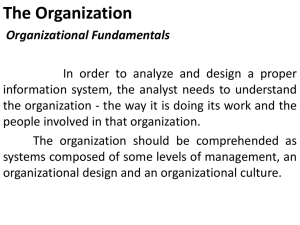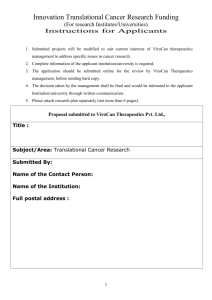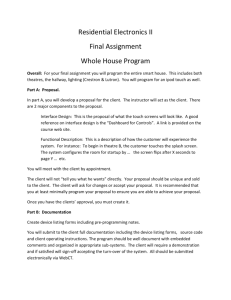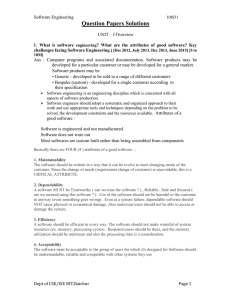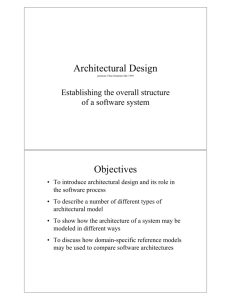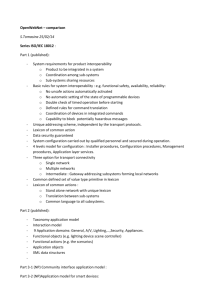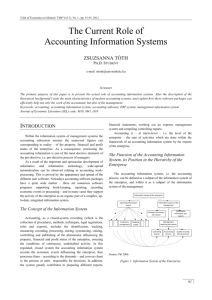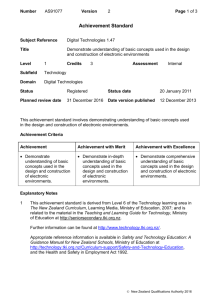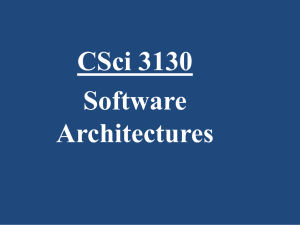basic concepts of systems
advertisement
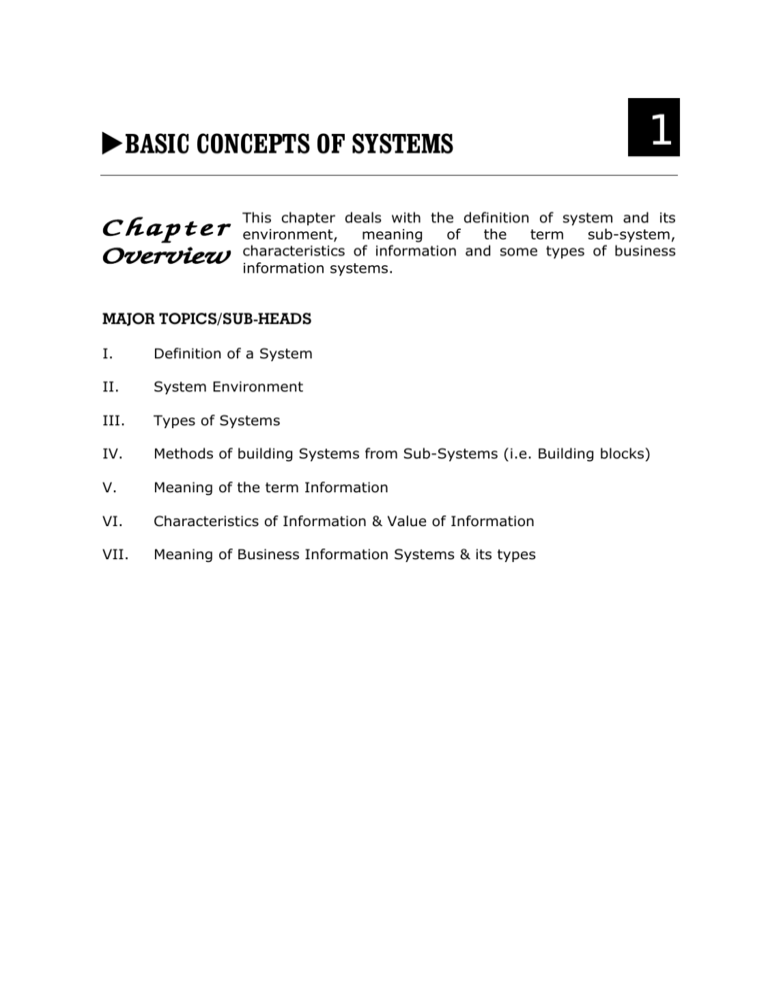
BASIC CONCEPTS OF SYSTEMS 1 This chapter deals with the definition of system and its environment, meaning of the term sub-system, characteristics of information and some types of business information systems. MAJOR TOPICS/SUB-HEADS I. Definition of a System II. System Environment III. Types of Systems IV. Methods of building Systems from Sub-Systems (i.e. Building blocks) V. Meaning of the term Information VI. Characteristics of Information & Value of Information VII. Meaning of Business Information Systems & its types 2 I. Management Information & Control Systems DEFINITION OF A SYSTEM A system could be defined as: • A set of inter-related components (What it is) • Operates collectively (How it operates) • To accomplish common goals (Its purpose) Let us take some examples to understand the term System Example 1: Business systems Components : Men, material, money, machine - work collectively for: Common goal: Profits/market share Example 2: Computer based information systems Components: Hardware, software, data, people - operate collectively for: Common goal : Providing timely information to authorised users Classification of Systems Abstract systems Physical system Orderly arrangement of interdependent ideas Set of elements operating together to accomplish Obj. Ex: Moral values/ethics Ex: Railway systems General model of a physical system Input Processes Ex: Computer information systems Output 3 Basic Concepts of Systems Data Calculations/ Word processing (Processes) (Input) II. Work sheet/ business letters (Output) SYSTEMS ENVIRONMENT It can be defined as: • Elements surrounding the system • That are outside the system and interact with the system Example: Environment of a business system. Government Supplier BOUNDRY BUSINESS SYSTEM Consultants Competitor Boundary: Features which define and delineate (separate) a system from its environment- forms its boundary III. TYPES OF SYSTEMS Types of Systems Deterministic/probabilistic Systems 1. Closed/relatively closed & open systems Deterministic systems: • Operates in a predictable manner • Interaction among parts known with certainty • Ex: Calculator has programmed logic for addition /subtraction 4 Management Information & Control Systems 2. 3. 4. 5. IV. Probabilistic systems: • Systems have a probable behaviour • A degree of uncertaininty or error is attached to what a system would do • Ex: Human system- some degree of uncertaininty as to how he will behave in a given circumstance Closed systems: Such systems are: • Self contained • Donot interact with environment • Tend to degenerate • Ex: Any government if it fails to interact with people & get its views/sensitive to public opinion will be voted out of power Relatively closed systems/isolated systems: • Deliberately designed to be as closed as possible • Intention is to prevent unwanted influence from environment • Ex: Computer program accepts only pre-defined input, processes them and gives pre-defined outputs. Open systems: • Interacts with the external environment, receives input and gives output • Tends to adapt to changes in external environment for survival and growth SUB-SYSTEMS These refer to parts/building blocks of larger systems. For example the sub-systems of a Business System are as follows: Business systems Finance sub-system Equity division Banking division HR sub-system Payroll Training 5 Basic Concepts of Systems Supra systems: Formed by a system and equivalent systems with which it interacts. Ex : Any Bank can be looked up as a supra-system it interacts with various other Banks Principles/ methods of building system from sub-systems: The following are some the principles/methods to be followed while constructing a system from its sub-systems : A. Decomposition: A complex system is difficult to understand. Hence break it up/decompose it into smaller identifiable blocks (sub-systems). Let us take an example of writing a book on MICS. To write a book on MICS (System) Chapter 1 (Sub-system) Topic 1 Topic 2 Chapter 2 (Sub-system) Topic 1 Topic 2 Chapter 3 (Sub-system) Topic 1 Topic 2 • Decompose the book into chapters- Chap.1, Chap.2 … • Decompose the chapter into topics- Chap.1- Topic 1, Topic 2 Chap.2- Topic 1, Topic 2, and Topic 3 etc. There should be functional cohesion among components: i.e. to say in the above case the topics within the chapters should be related to justify grouping under the same chapter, and then all the chapters should be related to MICS to justify their place in the book on MICS. B. Simplification It refers to organising the sub-systems in such a manner so as to reduce the number of interactions. How is simplification done? • Through clusters/groups of sub-systems which interact with each other and then a single interface with other sub-systems/clusters 6 Management Information & Control Systems Ex: A Firm of Chartered Accountants can be looked up as a system and different divisions like audit, taxation and company law matters can be looked up as sub-systems. Members of each division interact among themselves and are represented to the client/IT department/ CLB through a partner, who is a single interface. C. Preventing system entropy (preventing unavailability) • Entropy prevented through inputs to repair, replenish and maintain systems • Such maintenance inputs are called as “Negative Entropy” System Impact of entropy 1. Computer Application 2. Electrical utility co. 3. Cellular operator i. Fails to meet user Requirement Negative entropy (Maintenance input) Program modifications, enhancements ii. Errors Debug/repair programs i. Power thefts Shielded wires/ spot checks ii. Increase in demand Extended wiring i. Wrong billing Testing of billing software D. System stress & system change Stress: • • • Meaning Effect Purpose : : : Force transmitted by systems’ supra-system Causes system to change To enable supra system to better achieve its goals Each level of system trying to accommodate stress – may impose stress on its sub-system and so on…… Form/type of stress A change in Goal set Change in desired achievement level 7 Basic Concepts of Systems Ex: RBI Directive to all member Banks to implement RTGS/cheque truncation Each Bank’s top management passes it on: Clearing department to modify / upgrade its clearing system Clearing cell passes it on: EDP department to develop new software to suit RTGS Impact of Stress on a system: The impact of stress varies depending on whether a system reacts or does not react to stress. Impact of stress on the system Adapt to accommodate Stress & hence survive Structural Change V. Be inert/pathological to stress & ultimately decay Process Change INFORMATION It refers to data that have been put to meaningful use/context Ex: School management wants to know which subject/students require more attention Data available: Marks of all the students in 5 subjects Processed data: Tabulate the data and sort it / prepare %s to get better idea on performance. Hence: DATA WHEN INFORMATION (RAW PROCESSED MATERIAL) (OUTPUT) BASIS DECISION FOR MAKING It may be noted that quality of data determines the quality of information and hence the quality of decisions 8 VI. Management Information & Control Systems CHARACTERISTICS OF INFORMATION 1. Timeliness : Available when required 2. Purpose : Must have a transmission 3. Mode & format : Mode- visual, verbal or written Format- so designed to assist decision making (Ex: Classified/ tabulated/ exceptions only ) 4. Redundancy : Excess information per unit of data 5. Rate : Number of numeric characters /minute – for humans Number of bits/second – for machines 6. Frequency : Periodicity of information flow 7. Completeness : As complete/comprehensive as possible 8. Reliability : Source from which information originates should be reliable/ confidence level high 9. Cost benefit analysis : Benefits derived from using the information should justify cost of procuring the information 10. Validity : Information should close to the purpose it purports 11. Quality : Correctness (Ex: Without any personal bias) purpose at the time of CONCEPT OF VALUE OF INFORMATION: = = VALUE OF “CHANGE IN DECISION / BEHAVIOUR” CAUSED BY INFORMATION OUTCOME OF NEW DECISION CAUSED BY INFO.(LESS) OUTCOME OF OLD DECISION LESS COST OF OBTAINING INFORMATION LESS COST OF OBTAINING INFORMATION 9 Basic Concepts of Systems Example: • Mr. is approached directly by a prospective buyer to buy his Rs.50 lakhs (old decision) house for • A real estate agent brings a new person who is willing to pay Rs 60 lakhs (new decision) • Agent commission is 1% of sale value Hence value of information given by the agent is : = = = (Rs.60 lakhs (less) Rs.50 lakhs ) less (1% of 60 lakhs) 10 lakhs (less) Rs.60 Thousands Rs.9.4 lakhs It may be noted that the above example deals with value of information that has been calculated for change in revenue flows. Value of information can also be calculated for change in costs. VII. BUSINESS INFORMATION SYSTEMS (BIS) • Business systems depends on information systems • BIS = Data flows/information flows among components of Business ( i.e. among various departments) • Its purpose is to process input, maintain records and produce information output. Categories of information system i. ii. Transaction processing systems • Aimed at meeting business functionality/business operations • Ex : Billing software is aimed at improving routine business activity of billing Management information system (MIS) • Assist management in decision making and problem solving • Use results of transaction processing and other information • Supports routine decisions • Ex: Total sales data region wise from transaction processing – forms input for region wise sales analysis 10 Management Information & Control Systems iii. Decision support systems (DSS) • For managers to solve unique/non-recurring/semi-structured decision problems • Should have greater flexibility to meet uncertain environment • Build problem models and alternate solutions explored • Ex: “What –If” analysis in MS Excel Components of DSS software: USER INTERFACE + DATA BASE (EASY TO USE QUERY (FOR DATA) LANGUAGE) iv. + MODEL BASE (FOR BUILDING PROBLEM MODELS) Executive information system (EIS) • Strategic levels of management pushed DSS to lower-levels of management because technical knowledge needed to build models and there was some difficulty in use Hence EIS was introduced. It has the following characteristics / features: • Easy to extract summary from data base and model complex problems • Knowledge of complex query language was not required • Ease of use / graphic representation • Ability to incorporate data even from external/public databases • Data “drill down” facility • Externally focused/ strategically based Basic Concepts of Systems v. 11 Expert systems • To replace need of human experts where expertise is scarce and hence expensive (Ex. Rocket science, oil drilling, nuclear science ) • Specific to given area and cannot be generalised i.e. to say that an Expert System meant for oil drilling will not work in the area of nuclear science. • It has resulted from academic research in the field of Artificial Intelligence (AI) . 12 Management Information & Control Systems QUESTIONS 1. Define the term “System”. What are the two broad classifications of systems? Explain with an example each. 2. What are the various types of systems? Explain with examples. 3. Write Short Notes on: a. Systems Environment b. System Entropy c. System Boundary d. System Stress e. Sub-systems f. System Change g. Decision Support System (Nov 2002) h. Decomposition (May 2003) i. Simplification j. Expert Systems (May 2004) 4. “Information to be useful and effective bears certain characteristics”Explain 5. Explain the term value of information 6. Explain briefly the various categories of information systems. (Nov. 2001)
